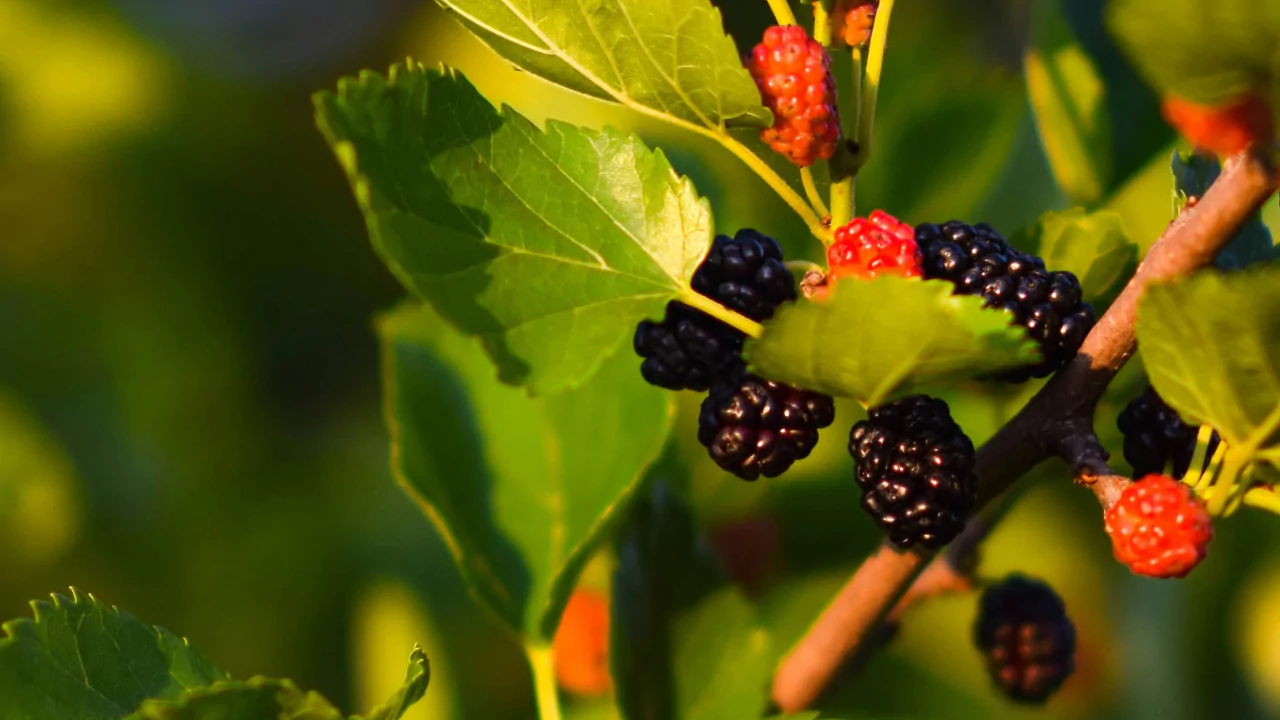
The white mulberry tree (Morus alba) is native to Japan and China, where it has been cultivated for thousands of years because it is a primary food source for silk worms.
Settlers attempted to establish a silk industry in the U.S. by importing mulberry trees into America at the beginning of the 1800s. Unfortunately, due to high costs associated with silk production, the venture proved unsuccessful.
Decendants of these white mulberry trees can still be found growing wild across parts of the United States. They are hardy in USDA plant hardiness zones 4 through 8.
White mulberries have broad adaptability for different soil conditions. However, they grow best under full sun and rich well-draining slightly acidic soils. Some species are invasive and prolific self seed in mild moist climates.
In contrast to white mulberries, red mulberry trees (Morus rubrum) are indigenous to the USA and can be located in shaded woodlands or near streams and creeks. Also hardy in USDA plant hardiness zones 4-8, these trees are more finicky than white mulberries as they strongly prefer partial shade and rich moister soils over sunlit dry locations.
Black mulberry (Morus nigra) is indigenous to Iran and grows only in the milder climates of USDA zones 7 through 10. It does tolerate a bit more drought than other species of mulberries, which prefer full sun and warmth.
Mulberry trees generally grow to an approximate height of 40 feet. Most homeowners plant them for landscaping purposes, however adornment will not be their forte since glossy leaves do not yield symmetrical shapes or forms. There are some wining and dwarf varieties one could consider though.
The majority cultivators tend to have preferential aims regarding the fruit harvest. The fruit itself resembles large black berries and varies in shape depending on the variety or species selection, retrieval has been notably simple as it is sweet and does not require preservation efforts other than storage used for berries alike.
The color phases of ripening mulberry fruit includes white, red, purple or black colors. Ripened fruits will simply falloff from branches making collection effortlessly easy. Another hurdle during retrieval along with personal competition would include birds as well who very much enjoy mulberries.
Presumably because the production commercially ceases to exist due to poorly shipping laden dolmenteria elloop and therefore earns right for home gardens.
However, consider that mulberry fruit is quite messy. The staining of patios, cars and other surfaces is the result of their dropping. Additionally, it can be tracked into your house on the soles of shoes.
If you opt for mulberry planting, do so in the far corners of the garden where there are no footprints to minimize foot traffic. You are advised to harvest them daily as they begin to soften.
Planting Mulberry Trees
In purchasing a mulberry tree make sure you select one suited to your area because not all species grow well in all regions. Both red and white mulberries have a lifespan of up to seventy five years while black mulberries can live over three hundred years.
Although most cultivars are self fertile some require both male and female plants. Please confirm with your supplier that’s providing these trees.
To ensure proper growth place the tree in an area receiving full sunlight. Digging half again as deep and wide as the root ball creates adequate space for both soil and roots . After placing soil around half-way filled digging cavity add two gallons water before filling up the space completely while firmly stuffing soil with feet.
After planting, ensure to water the mulberry tree at least once per week until it is established. In hot and dry weather, water more so that the soil remains moist 2 inches below the surface.
Once fully grown, you may need to add water only occasionally to keep the soil slightly moist. If the tree is located in an area with irrigated lawns, it might take no additional water supply from you.
Mulberries generate fruit on new wood. Schedule pruning during winter or early spring before new growth starts showing for seasonal maintenance. As with other fruit-bearing trees, prune mulberries primarily to control unwanted growth and remove dead and diseased branches; there is no need for opening canopies like in orchard fruits; therefore, minimal pruning suffices.
In spring, apply mulch around the base of the trees fertilizing them with 1 pound of 10-10-10 NPK mix spread under the canopy.
Pests and Disease
In general mulberries suffer from very little pests and diseases, although they may have borers or aphids. White mulberries are sometimes afflicted by a disease known as popcorn disease which causes affected fruit to develop popcorn-like growths.
These fruits should be removed and destroyed if found to prevent further spreading.
Varieties
- ‘Illinois Everbearing’ is one of the most versatile varieties. This hybrid of a white and red mulberry is hardy from USDA zones 4 through 9. It produces sweet, elongated berries the froset year after planting. Grows to 35 feet tall.
- ‘Oscar’ is one of the best white varietes with raspberry flavored fruit . Hardy in zones 6 through 9, grows to a height of thirty feets.
- ‘Beautiful Day’ is a white variety that produces white fruit. The fruit won’t stain and can be planted nearer to dwellings. Hardy only in zones six through nine.
- ‘Noir de Spain’ is a beautiful black variety that has a spreading habit and large heart shaped leaves. Hardy in regions 8-10.